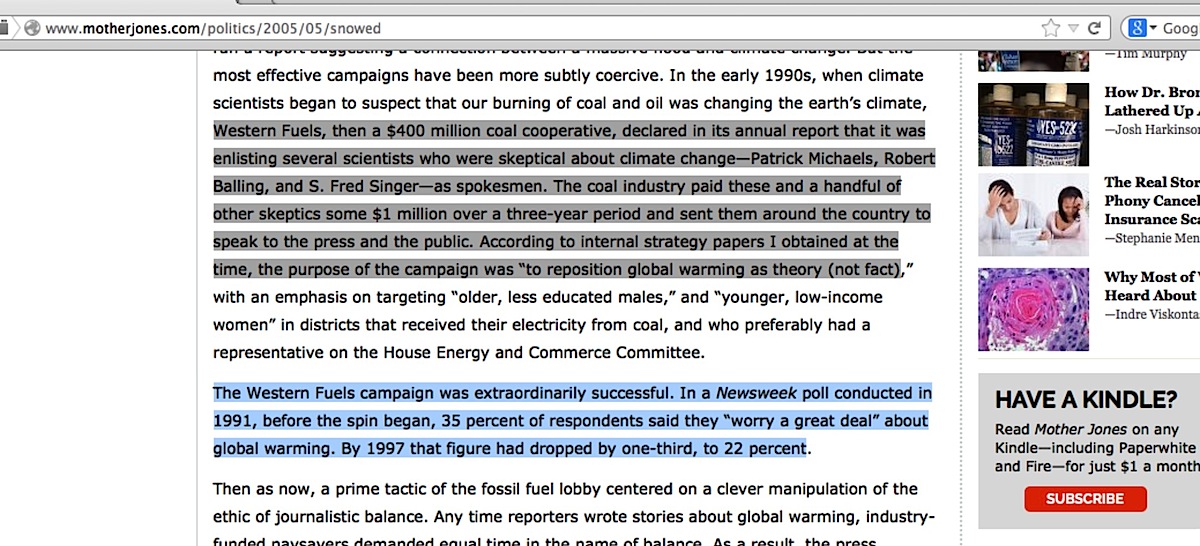Ross Gelbspan’s “Snowed” article in the May/June 2005 issue of Mother Jones magazine described how a ‘misguided application of journalistic balance’ and ‘a decade-long campaign of deception, disinformation, and, at times, intimidation by the fossil fuel lobby’ was causing the media not to properly warn us about the perils of global warming. Accept his narrative without question, and it’s a rallying cry to solve the problem. But notice the errors in his article’s 5th & 6th paragraphs, and it makes you wonder how much more he gets wrong.

Let’s recap a few of the problems seen in the 5th paragraph:
- … its annual report that it was enlisting several scientists – I detailed the wipeout of the word “enlisted” here
- … Patrick Michaels, Robert Balling, and S. Fred Singer—as spokesmen – Dr Singer was never a part of the PR campaign
- … paid these and a handful of other skeptics some $1 million over a three-year period – David Helvarg’s November, 1996 “The Greenhouse Spin” article in The Nation magazine says the campaign only lasted 6 months** [See Author’s 12/19/14 note below] (full context here or here, pgs 3-5)
- … and sent them around the country to speak to the press and the public – no, it was to just three small cities for brief media interviews, combined with with some newspaper ads and around four or so weeks of radio ads playing for just 3-7 times throughout the entire day.
- … According to internal strategy papers I obtained at the time – or that the Ozone Action organization, or both, obtained at the time, depending on which of three narratives one chooses to read
- … the purpose of the campaign was “to reposition global warming as theory (not fact)” – this statement being the alleged smoking gun evidence to indict skeptic scientists, which Gelbspan has never shown in its full context
That’s six major problems in a single 5-sentence part of one paragraph. And I’ll have to save what he said in its first sentence about a TV editor being threatened “with a withdrawal of oil and automotive advertising” for an entirely separate blog piece later.
Then there’s his 6th paragraph,
The Western Fuels campaign was extraordinarily successful. In a Newsweek poll conducted in 1991, before the spin began, 35 percent of respondents said they “worry a great deal” about global warming. By 1997 that figure had dropped by one-third, to 22 percent.
WFA’s “Information Council for the Environment” that Gelbspan so widely touts as smoking gun evidence of a top-down industry directive ‘to reposition global warming as theory rather than fact‘ lasted just six months** [See Author’s 12/19/14 note below] in its entirety, with the actual PR tour being restricted to just three cities in May of 1991 and maybe a single 60-second national radio ad on Rush Limbaugh’s program at that time. If people within the reach of the media markets of Fargo, Bowling Green and Flagstaff weren’t newspaper readers, or didn’t pay attention to the radio ads, or had a different TV program on during that time, they would have never seen it. And if the rest of the nation missed the Limbaugh radio ad – assuming it did actually get broadcast time – there’s no way on Earth that the campaign would have had any effect on people’s opinion about global warming. Researchers would be hard-pressed to find few references – if any – to the ICE campaign back in 1997 as something influencing the public to be skeptical about man-caused global warming.
Contrast that to Gelbspan’s influence. Just this past May, an out-of-the-blue commenter at my own Facebook page felt compelled to ‘rebut’ an article I linked to by copying a line straight out of an April 2005 Mother Jones interview of Gelbspan (which mentioned his upcoming “Snowed” article); the line about Western Fuels from Gelbspan’s “Snowed” article carried enough influence that it was reproduced in a 2007 book and repeated elsewhere; and the entire article is linked to by many, with one year-old book’s remark about skeptics’ corruption saying, “This activity has been widely documented, but the best summary is provided by Ross Gelbspan, “Snowed”, Mother Jones, May/June 2005.”
Readers of this blog might find that last bit familiar. It’s what prompted me in 2009 to find anybody who independently documents the “corruption”. But all I’ve found is endless problems with the accusation… and where the true influence of the issue regarding public opinion of skeptic climate scientists is apparently seen.
**[Author’s 12/19/14 note: Having looked through “Greenpeace USA née Ozone Action”’s ICE scans for this length of time now, I myself am more inclined to say it only lasted five months, January to late May 1991. I may be able to provide irrefutable evidence of its time frame later.]
